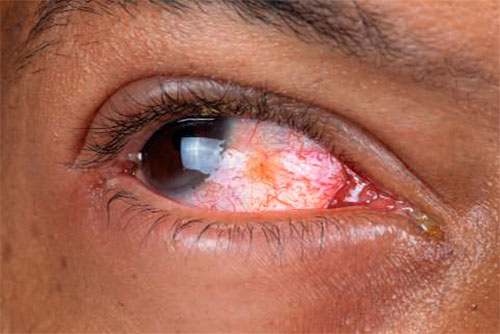Conjunctivitis and the Role of Cosmetologists: A Comprehensive Approach
In the diverse field of cosmetology, professionals often deal with more than just aesthetic enhancement. A crucial aspect of their role involves managing the intersection of beauty and health, which includes recognizing signs of common conditions such as conjunctivitis, also known as “pink eye”. This article provides a comprehensive exploration of conjunctivitis in the cosmetology context, discussing the condition, its impact on cosmetology practice, and the steps cosmetologists can take when faced with a client exhibiting signs of this condition.

Conjunctivitis
Understanding Conjunctivitis
Conjunctivitis is an inflammation or infection of the conjunctiva, the clear membrane lining the inner part of the eyelids and the white part of the eye. The condition can be caused by various agents, most commonly bacteria or viruses, but also allergens or irritants. Given its contagious nature—particularly in bacterial and viral forms—conjunctivitis poses a significant challenge within the cosmetology setting.
Recognizing Conjunctivitis in the Cosmetology Practice
Cosmetologists should be adept at recognizing the primary symptoms of conjunctivitis:
- Redness in the white of the eye or inner eyelid
- Increased tear production
- Thick yellow discharge crusting over the eyelashes, particularly after sleep
- Green or white discharge from the eye
- Itchy or burning eyes
- Blurred vision or increased sensitivity to light
Noticing any of these signs in a client should prompt immediate action from the cosmetologist.

Managing Clients with Conjunctivitis
The close-contact nature of cosmetology services increases the risk of spreading conjunctivitis. If a client presents with signs of the condition, the cosmetologist should politely reschedule the appointment and recommend the client see a healthcare provider immediately. It’s essential to handle this conversation with tact and sensitivity, explaining that the safety and health of both the client and others is of utmost importance.
Preventing the Spread of Conjunctivitis in the Cosmetology Setting
Due to the contagious nature of conjunctivitis, cosmetologists should adopt robust hygiene practices:
- Sterilize tools: Clean and sterilize all tools before and after each use.
- Use disposable equipment: Whenever possible, use disposable tools, particularly when working around the eye area.
- Maintain personal hygiene: Regular hand washing is critical. Avoid touching your own eyes, nose, and mouth, and always wash hands before and after interacting with each client.
- Educate clients: Encourage clients to seek immediate medical attention if they suspect they have conjunctivitis, and to reschedule appointments until they have recovered.
The Role of the Cosmetologist
Cosmetologists play an instrumental role in recognizing signs of health issues like conjunctivitis. However, it’s crucial to remember that while cosmetologists can identify potential signs of these conditions, diagnosing and treating them falls under the purview of healthcare professionals. The cosmetologist’s role is to maintain a safe and hygienic practice environment, respect the boundaries of their profession, and refer clients to appropriate medical professionals when needed.
The role of a cosmetologist is multi-faceted, blending beauty and health in unique ways. Recognizing and managing situations involving conditions like conjunctivitis is crucial to maintaining a safe and successful practice. By understanding the condition, adopting rigorous hygiene practices, and making timely referrals to healthcare providers, cosmetologists can continue to provide a high level of care for their clients.






